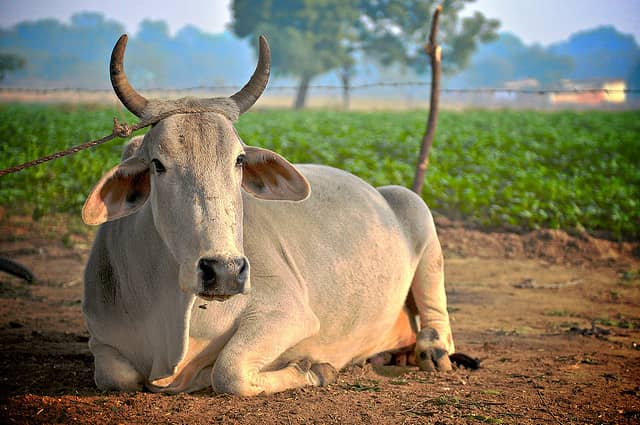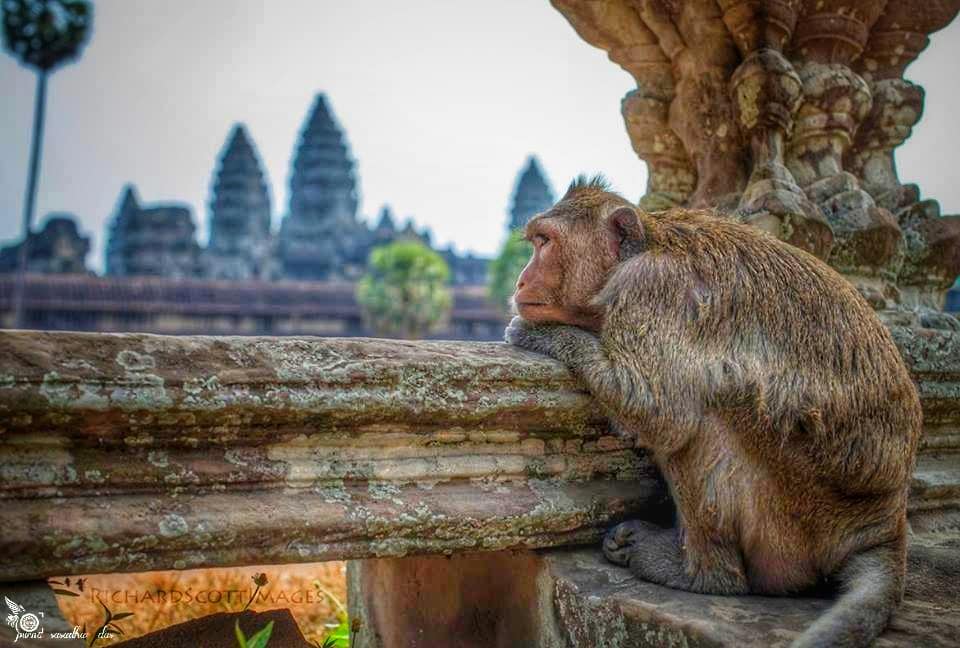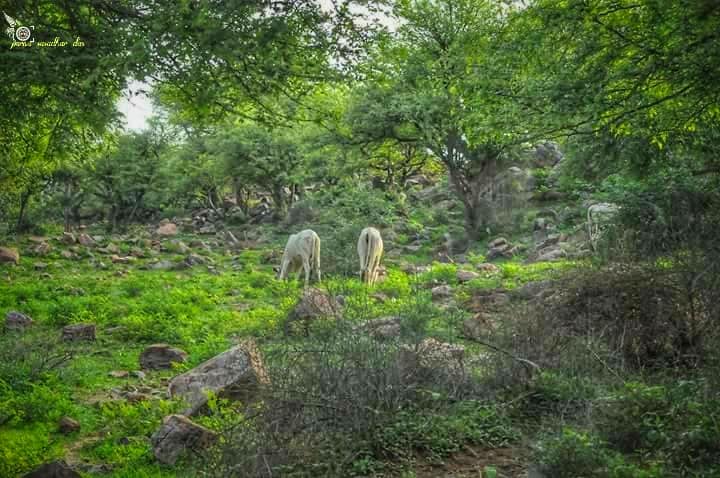Mahanidhi Madan Gopal Das
Welcome all lovers of Vrindavana! This is Part Seven of our continuing series of articles glorifying Sridhama Vrindavana. Vraja [aka Vrindavana] is the divine realm wherein Sri Krishna loves, plays and sports with all and everyone. If you simply visit Vraja or live in Vraja, Gopala will enchant your heart by His sweet love, beauty, charm and naughty playfulness.
Filled with thousands of temples, Vrindavana is known as a “temple town”. In fact, the entire 168 sq. mile area of Vraja Mandala is adorned with thousands of temples, sacred places, mountains, rivers, lakes and bathing tanks.
Bhakti-ratnakara, a 500-year-old holy book penned by Gaudiya Acarya Sri Narahari Chakravarti, describes over 300 different inhabited villages still existing today in Vraja Mandala. Each village is named after and commemorated to a particular amazing pastime of Sri Krishna which occurred there.
Vraja Dhama ki jai ho! This is such a unique and captivating sacred place. In every square mile of Vraja Mandala, one can visit two villages named after a divine lila that Sri Krishna enacted there 5,000 years ago! Here in Vraja, every step is a celebration of love leading us from village to village, lila-to-lila, and on into Krishna’s heart.
These articles are meant to increase attract everyone more and more and more to this most astonishing, wonderland of pure love and never ending play. Sri Krishna’s pastime villages will be grouped by area like Kamavana, Govaradhana, Varsana, etc. The villages will be listed by their modern names. The origin of that name will appear in brackets after its English translation.
Sri Vraja Dhama ki jai!
Vraja Dhama! O, What an amazing sacred place? In every square mile of Vraja Mandala, one can visit two villages named after a divine lila that Sri Krishna enacted there 5,000 years ago! Here in Vraja, every step is a celebration of love leading us from village to village, lila to lila, and on into Krishna’s heart.
Nandagaon & Kokilavana Area Lila Villages
Now come, let us wander through the northern area of Vraja Mandala around Nandagrama to uncover more hidden lila sthalis full of bliss.
** Kosi (Kosikalan)
While waiting here in a kunja, Radhika pretends not to recognize Her eternal beloved when Syama knocks on the bamboo door.
“Who is that?”, Sri Radha tauntingly says from behind the door.
Krishna: I am Krishna.
Radha: O, a black snake has come here to bite Me? Just go from here, slither into the forest and leave Me alone. [word Krishna means black snake]
Krishna: No Priyaji, listen it’s Me—Ghanasyama!
Radha: O, no, no, no! I don’t want any thick rain clouds [ghanasyama] drenching My kunja!
Krishna: Come on Kisori, I am Cakri, wielder of the Sudarsana cakra.
Radha: Sorry, no need, My father has thousands of water pots [cakri].
Krishna: I am Madhusudana.
Radha: There are no blossoming flowers inside this kunja, little bee [madhusudana], so just fly away to some white flowers and drink some honey.
Krishna: What are You saying? It’s Me, Hari, your dearest!
Radha: I am very afraid of being scratched and bitten by a lion [hari]. So just run away somewhere into a deep forest!
May we someday come to Kosi, and hear this wonderful joking pastime of Lila Yugala, Radha Govinda.
** Nari-Semaré (near Chata)
These are two combined villages (Nari & Semari), of which, Semari is the residence of Syamala, a friendly sakhi of Radha. Here, Srimati Radhika is feeling so angry and jealous with Krishna that none of the sakhis even Her confidante Visakha-sakhi can break it. As advised, Krishna arrives disguised as a beautiful girl playing a vina.
Marvelling at her beauty and virtuosity in music, mystified Madhuri asks, “O sakhi, what is Your name and where are you from?”
Krishna [sakhi] “My name is Syamari. I am a celestial Kinnari, and I have come to entertain You.”
To reward Syamari for her stunning performance, Radha starts to drape a costly diamond necklace around Syamari’s lovely neck.
But Syamari [Krishna], immediately lifts her arms to stop Radha while begging with folded palms, “O sakhi, I don’t need a diamond necklace. I just want You to give up your sulky angry mood [maan].” Seeing through the ruse, Radha immediately wraps Ramana in a tight loving embrace while all the sakhi/manjari’s cheer:
“Jai Jai Sri Radheeeeeeeeeeeeeeeeee—SYAMA!” Thus the village is named.
** Baithäna (Baithana)
Name derived from baithaka [sit]. Here Nanda Baba, Upananda and the village chiefs sit down to discuss the welfare of Krishna, Baladeva and all Vrajavasis in Baba’s kingdom. It’s said that the love and hospitality of Vrajavasis here was so amazing, that only in this village did Sri Sanatana Goswami stay for more than one night as he wandered around Vraja Mandala.
** Rasauli Grama
Near Kotvana and Chota Bhaitan. Puranas say this village is the actual, original site of the Srimad Bhagavatam (10.29-33) Maha Rasa Lila. Hence the name Rasa-uli.
In 2017, Sri Pandit Baba personally showed us this lila sthali, with its Rasa mandala, forests and small “Yamuna” river meandering between its sandy banks. Indeed, a very beautiful, tranquil divine spot.
** Kamara [blanket/lust]
Village name is derived from a lila involving a woollen blanket and divine, spiritual desire or love [kama]. Feeling extremely eager to meet Priyaji and all the gopis, Priyatama Syama summons them all to His side. Radhika and the playful sakhis decide to play a trick on Krishna. Without Syama seeing, the sakhis snatch Krishna’s favorite black blanket [kari kamara] and hide it.
Not finding it, Krishna goes home to complain to Maa Yasoda: “Maiya, while I was grazing cows just now, the pesky sakhis stole My blanket. When I ask them to return it, they say, ‘O Kanhaiya, I saw Your old blanket floating in the Yamuna.’ Maa, another sakhi then says, ‘Hey Gopala, I saw a cow eating Your blanket.’ A third sakhi then teases Me, saying, ‘If you dance for me, then I will buy You a new blanket.’
Maa Yasoda caresses Gopala to her bosom, and says, “O Lala, don’t worry, just go back, and I am sure the gopis will return your blanket.” Upon returning, the gopis give back the black blanket, and then lead Syama into a dark, shady Keli Nikunja to dive in the waves of Radha’s mysteriously sweet love.
Krishna Kanhaiya ki jai! Radha Govinda Yugala ki jai!
** Basosi
Village near Sesasayi. When Krishna comes here, the bees hover all around Syama, smelling the sweeter than sweet fragrance of Krishna’s transcendental form. Basa means fragrance and so the village name, Basosi.
While throwing colors on each other here during Holi, Krishna and the gopis fill the atmosphere with the beautiful flower-like, sandal-scented, natural fragrance of Their beautiful limbs.
** Paya-gaon
10 km. east of Kosi. Feeling hungry because His tiffin has not come, Krishna, Dou and all the gopas do madhukari here, and drink the milk [paya] loving offered by the sweet hands of the Vrajavasis.
** Sesasayi
While sporting here with Srimati and the damsels of Vraja, Krishna tells the lila of Visnu lying on the snake bed of Anantasesa in the milk ocean. Entering the bhava and lila of His form as Anantasayi, Sri Krishna lies down on a huge lotus flower in the middle of a clear water lake.
Srimati adopts the bhava of Visnu’s consort, Laksmi-devi, and massages Krishna’s lotus feet. Astonished, the gopis look on and cheer, “Visnu Visnu Visnu! Syama Syama Syama! Jai Jai Sri Radhe!”
Here today, one can see a large lake called Ksirasagara.
** Kashrata
Kashrata means [exercise or wrestle]. While Radha-Krishna and the sakhis play and sport here, Radha says, “O Pranavallabha! You always boast about your strength, and how You’ve defeated the strongest gopas like Sridhama and Subala!”
Krishna interjects, “That’s right, no one in the whole universe can defeat Me!”
Radhika replies, “O yea? If that’s so, then now just wrestle with us. If by chance you defeat us, then we will believe Your boasting.”
Radha removes Her bangles, ties up Her hair, and folds Her dress. Slapping Her arms like a wrestler, Rai starts tussling with Syama. Within minutes, Radhika easily pins Krishna on the earth. Then all the sakhi/manjaris clap their hands excitedly while crying out happily, “Jai Sri, Jai Sri, Jai Sri Radhe!”
Radha-Krishna nitya Vraja madhurya lila ki jai! Jai Jai Sri Radhe!







